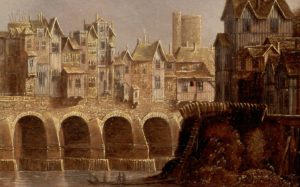 Through the diary of Samuel Pepys, we get a remarkable insight into the City of London in the seventeenth century. Here, amongst Samuel Pepys’ political exploits, and his reports of the Navy, the King and the Court, we can also get a picture of where and how his wife Elisabeth shopped at the time.
Through the diary of Samuel Pepys, we get a remarkable insight into the City of London in the seventeenth century. Here, amongst Samuel Pepys’ political exploits, and his reports of the Navy, the King and the Court, we can also get a picture of where and how his wife Elisabeth shopped at the time.
Elisabeth loved clothes and fashion, and both she and her husband aspired to move upwards in society. The Restoration was a fabulous time for fashion as people reacted against Cromwell’s Puritan repression with lace, bows, frilled petticoat breeches, and yards of flowing ribbon, even for men.
In 1661 the diarist John Evelyn commented on one young man had ‘as much Ribbon on him as would have plundered six shops, and set up Twenty Country Pedlars; all his body was dres’t like a May-pole’.
Elisabeth often shopped at Unthank’s the tailors, a large shop in Charing Cross, where she was measured for her gowns, and would choose fabric and cloth. Unlike shoemakers and bootmakers, whose leather work could be done on stalls in the open air, tailors usually worked indoors out of the weather. By the end of the 17th century more exotic and valuable fabrics from abroad such as East Indian chintz became popular.
the end of the 17th century more exotic and valuable fabrics from abroad such as East Indian chintz became popular.
Sometimes more expensive fabric, such as chintz or silk, was supplied by the client, leading to tailors being seen as cheaters, because the client suspected they skimped when making up the fabric and used the left-overs to make smaller garments they would then sell on. Many pamphlets of the time describe tailors in this rather unflattering way.
A range of accessories that were both decorative and practical were available. Decorative muffs acted as a place to store handkerchiefs, purses and perfumes. Hoods, both attached to, and unattached to cloaks were popular too, with some shops only selling hoods. Opposite – ribbon-trimmed gloves from the V&A.
In the diary, arguments between Samuel and Elisabeth were frequent, especially over money. For example after the Duke of Gloucester died and everyone was in mourning, Elisabeth overspent the fifteen pounds she’d been given for her mourning costume, and Pepys says ‘after I had looked over the things my wife had bought today…they costing too much, I went to bed in a discontent.’
Elisabeth would have taken her coins and tokens (coins were in short supply during Charles II’s reign) and go to the Royal Exchange, which before the great fire was the great centre of commerce in the city. The coins illustrated read: ‘Coffee Tobacco Sherbet tea and Chocolat retail’d in Exchange Ally’. The Exchange was officially opened in 1565 by Queen Elizabeth I, who awarded the building its Royal title. It had a central courtyard surrounded by more than 160 galleried shops. Some of these were little bigger than booths, and were so poky and gloomy that they had to be lit by candles, even in the daytime. The covered walks were decorated with statues of English kings.
Unfortunately, the Royal Exchange was destroyed in the Great Fire and had to be rebuilt. A statue of Gresham, who founded the Exchange, stood near the north end of the western piazza. After the Fire of 1666 this statue alone remained unharmed, according to Pepys’ records. Unlike today, only shopping, or the exchange of goods took place. Stockbrokers were not allowed into the Royal Exchange because of their loudness and rude manners, so they had to meet at Jonathan’s Coffee-House which was nearby.
Another street that was for fashionable ladies was Paternoster Row, which according to Stow in his book about London, ‘their shops were so resorted to by the nobility and gentry in their coaches, that oft-times the street was so stop’d up that there was no passage for foot passengers.’
Elisabeth also shopped for small linens in Westminster Hall, where it appears you were allowed to run up a bill on account. Mrs Mitchell and Betty Lane both had stalls there, where Samuel Pepys dallied with more than just lace and linen. Westminster Hall was a magnificent arched and lofty building, part of the Palace of Westminster, and some people were disgusted it should be used for trade. But it appears that chapels and palaces were all a part of Elisabeth Pepys’s shopping experience in the hedonistic era of the Restoration.
Pictures: The Ro yal Exchange, wikipedia
yal Exchange, wikipedia
Leather Tokens: London Museum via the Guardian
My book featuring Elizabeth Pepys is out now. myBook.to/MrPepys
CLICK HERE to tweet this post!
Find me on Facebook or on Pinterest or @swiftstory


